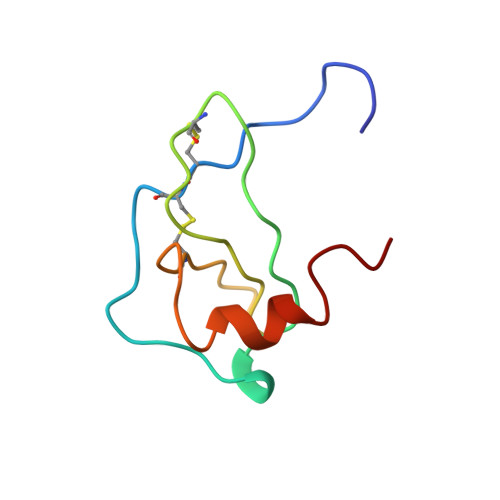Identification of amino acid residues critical for aggregation of human CC chemokines macrophage inflammatory protein (MIP)-1alpha, MIP-1beta, and RANTES. Characterization of active disaggregated chemokine variants.
Czaplewski, L.G., McKeating, J., Craven, C.J., Higgins, L.D., Appay, V., Brown, A., Dudgeon, T., Howard, L.A., Meyers, T., Owen, J., Palan, S.R., Tan, P., Wilson, G., Woods, N.R., Heyworth, C.M., Lord, B.I., Brotherton, D., Christison, R., Craig, S., Cribbes, S., Edwards, R.M., Evans, S.J., Gilbert, R., Morgan, P., Randle, E., Schofield, N., Varley, P.G., Fisher, J., Waltho, J.P., Hunter, M.G.(1999) J Biological Chem 274: 16077-16084
- PubMed: 10347159
- DOI: https://doi.org/10.1074/jbc.274.23.16077
- Primary Citation of Related Structures:
1B50, 1B53 - PubMed Abstract:
Human CC chemokines macrophage inflammatory protein (MIP)-1alpha, MIP-1beta, and RANTES (regulated on activation normal T cell expressed) self-associate to form high-molecular mass aggregates. To explore the biological significance of chemokine aggregation, nonaggregating variants were sought. The phenotypes of 105 hMIP-1alpha variants generated by systematic mutagenesis and expression in yeast were determined. hMIP-1alpha residues Asp26 and Glu66 were critical to the self-association process. Substitution at either residue resulted in the formation of essentially homogenous tetramers at 0.5 mg/ml. Substitution of identical or analogous residues in homologous positions in both hMIP-1beta and RANTES demonstrated that they were also critical to aggregation. Our analysis suggests that a single charged residue at either position 26 or 66 is insufficient to support extensive aggregation and that two charged residues must be present. Solution of the three-dimensional NMR structure of hMIP-1alpha has enabled comparison of these residues in hMIP-1beta and RANTES. Aggregated and disaggregated forms of hMIP-1alpha, hMIP-1beta, and RANTES generally have equivalent G-protein-coupled receptor-mediated biological potencies. We have therefore generated novel reagents to evaluate the role of hMIP-1alpha, hMIP-1beta, and RANTES aggregation in vitro and in vivo. The disaggregated chemokines retained their human immunodeficiency virus (HIV) inhibitory activities. Surprisingly, high concentrations of RANTES, but not disaggregated RANTES variants, enhanced infection of cells by both M- and T-tropic HIV isolates/strains. This observation has important implications for potential therapeutic uses of chemokines implying that disaggregated forms may be necessary for safe clinical investigation.
- British Biotech Pharmaceuticals Ltd., Watlington Road, Oxford OX4 5LY, United Kingdom. czaplewski@britbio.co.uk
Organizational Affiliation:















